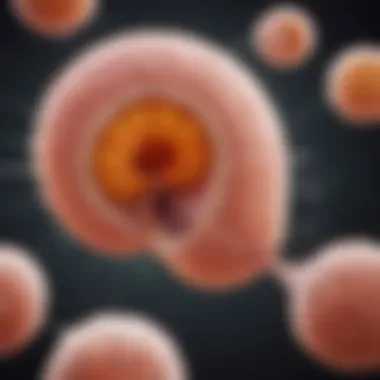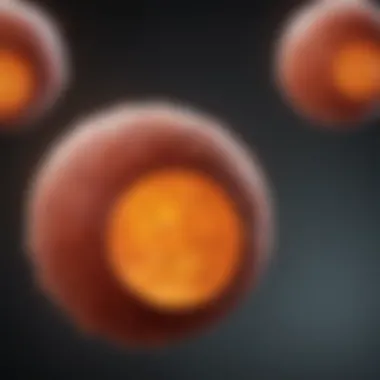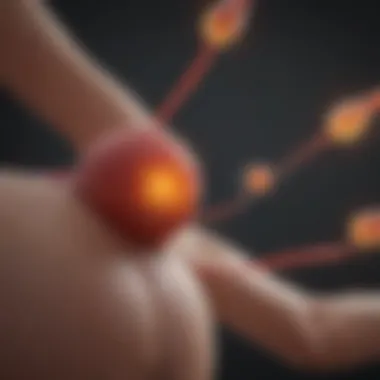Understanding Bladder Cancer: Stages and Grades


Intro
Bladder cancer, a condition often shrouded in complexity, represents not just a medical challenge but an intricate portrait of how tumor stages and grades intertwine to impact patient journeys. The classification of bladder cancer isn't merely academic; it directly informs the approach to treatment and management. By shedding light on these fundamental concepts, one can better grasp the landscape of bladder cancer, from diagnosis through to potential therapies.
Understanding the disease begins with recognizing that not all tumors are created equal. Bladder cancer stages describe how far the cancer has spread, while grades inform us about the aggressiveness of the cancer cells. It's essential to appreciate that a higher grade doesn’t always correlate directly with a later stage; this distinction can be particularly nuanced.
In essence, bladder cancer symptoms may prompt an initial consultation, but a detailed understanding of the stages and grades is critical in crafting an effective treatment plan. This article aims to dissect the specifics of these classifications, laying the groundwork for better comprehension and, ultimately, more informed health choices.
Knowledge of the key findings in recent research will also be provided, offering a window into evolving treatment protocols and new insights in the realm of bladder cancer management.
The Basics of Bladder Cancer
Bladder cancer, while not as frequently discussed as other malignancies, holds a significant place in the realm of oncology. Understanding the basics allows patients, healthcare providers, and researchers alike to navigate the complexities of this disease. From knowing the underlying mechanisms to identifying risk factors, a foundational grasp of bladder cancer is crucial for effective treatment and management.
At its core, bladder cancer arises when there are abnormal cells in the urinary bladder. These cells can proliferate uncontrollably, leading to tumors that may be either invasive or non-invasive. Early detection, characterized by an awareness of symptoms and risk factors, can dramatically improve patient outcomes. By delving into the primary aspects of bladder cancer, we prepare to tackle various stages and grades, which distinctly influence treatment decisions.
Overview of Bladder Cancer
Bladder cancer predominantly originates in the transitional cells lining the bladder wall, categorized as either superficial or muscle-invasive types. Superficial cancers are limited to the bladder’s inner layer while muscle-invasive cancers penetrate deeper, potentially affecting surrounding organs. The presentation of bladder cancer is often multifaceted, with symptoms ranging from blood in urine to persistent pelvic pain, making awareness integral to early intervention.
It's also paramount to acknowledge that bladder cancer isn't simply one single entity; it encompasses varied forms with different prognoses, treatment responses, and outcomes. Thus, fostering a nuanced understanding of its nature sets the groundwork for our journey into staging and grading, where the pathology becomes even more complex.
Epidemiology and Risk Factors
Bladder cancer isn't merely a random occurrence, as it carries with it specific epidemiological trends and identifiable risk factors. Understanding these elements helps mitigate risk and enhances preventative strategies.
- Demographics: Bladder cancer is generally more common in men than in women, with a higher prevalence among older individuals. The peak age for diagnosis tends to be around 70 years old.
- Geography: Certain regions report higher incidents, particularly North America and parts of Europe, where lifestyle factors like smoking and occupational exposures are prevalent.
- Lifestyle Factors: Smoking remains the most substantial risk factor, attributed to as much as half of all cases. Additionally, prolonged exposure to certain chemicals used in dyes, rubber, and textiles is linked to increased risk.
- Chronic Conditions: Conditions such as chronic cystitis or bladder stones also represent important risk factors. Their presence may lead to cellular changes that heighten the likelihood of cancer development.
In light of these factors, proactive measures such as regular check-ups for high-risk individuals can contribute vastly to the early diagnosis of the disease. Engaging in discussions around bladder cancer risk elevates awareness and empowers people to take ownership of their health and wellbeing.
As we progress in this exploration, it’s evident that understanding the basics is essential. It creates a framework for grasping the complexities of bladder cancer, guiding us seamlessly into the intricate world of staging and grading.
Understanding Stages of Bladder Cancer
Understanding the stages of bladder cancer is pivotal when it comes to both diagnosis and treatment. When doctors determine the stage, they essentially assess how far the cancer has progressed within the body. This categorization has real implications for the decisions made regarding treatment options, potential prognosis, and overall patient management. Identifying the stage enables healthcare providers to tailor therapies that align with the intensity of the disease, ensuring more effective outcomes.
Preamble to Cancer Staging
Staging is a systematic method employed in oncology to describe the extent of cancer in a patient's body. It encompasses various evaluations and tests. The American Joint Committee on Cancer (AJCC) and the Union for International Cancer Control (UICC) have standardized a system referred to as the TNM classification, which stands for Tumor, Node, and Metastasis. In this context:
- Tumor (T) describes the size and local extent of the primary tumor.
- Node (N) indicates whether the cancer has spread to nearby lymph nodes.
- Metastasis (M) assesses if the cancer has spread to distant sites.
Understanding the staging not only clarifies the current condition but assists in forecasting future treatment and outcomes. A stage IV diagnosis, for example, typically carries further concerns regarding the treatment's efficacy when compared to earlier stages.
Stage 0: Non-Invasive Tumors
Stage 0, or carcinoma in situ, denotes a critical point in the trajectory of bladder cancer. At this stage, abnormal cells are present in the innermost layer of the bladder lining but haven’t yet invaded deeper tissues. Though classified as "non-invasive," this stage demands urgent attention as untreated carcinoma in situ can evolve into invasive cancer over time. Treatment often involves methods like transurethral resection or intravesical therapy, where medication is directly administered into the bladder. Early intervention can significantly influence the patient's outcomes and stability moving forward.
Stage I: Invasive to the Lamina Propria


In Stage I, the cancer has penetrated the lamina propria, a connective tissue layer beneath the bladder lining. The cancer cells haven’t yet reached the muscle layer but have shown the potential to invade further. Patients diagnosed at this stage may face a variety of treatment routes, including surgery, chemotherapy, or immunotherapy. The significance of timely intervention cannot be overstated, as the longer the condition remains untreated, the more likely it is to spread to more layers of the bladder.
Stage II: Invasion into the Muscular Layer
When bladder cancer reaches Stage II, it signifies invasion into the muscular layer of the bladder wall. This progression denotes a more advanced form of the disease, raising the stakes for treatment. At this juncture, a more aggressive approach is often warranted. Options may include radical cystectomy, where the entire bladder is removed, often accompanied by neoadjuvant chemotherapy. The risk of recurrence increases significantly at this stage, necessitating close monitoring and comprehensive care plans to reduce the chances of future complications.
Stage III: Invasion Beyond the Bladder
Stage III is indicative of a significant escalation in the disease's severity. The cancer may have spread beyond the bladder to nearby structures, which can include the prostate in men or the uterus in women. Treatment is even more multifaceted and may incorporate a combination of surgery, chemotherapy, and radiation therapy. The approach aims not only to eliminate existing cancer but also to manage symptoms and enhance the quality of life. Additionally, ongoing clinical trials may provide options that are cutting edge, offering more targeted therapies.
Stage IV: Metastatic Disease
Stage IV represents the most critical phase of bladder cancer, characterized by the presence of metastatic disease. This stage indicates that cancer has spread to distant parts of the body, such as the bones, liver, or lungs. The broader systemic involvement necessitates a systematic treatment approach often entailing systemic chemotherapy, immunotherapy, or targeted therapies. Prognosis at this stage generally decreases considerably, which underlines the urgency of early detection and effective monitoring strategies. Careful multidisciplinary approaches involving oncologists, urologists, and palliative care specialists become essential to coordinate the comprehensive management of the patient's health.
"Understanding the stages of bladder cancer is crucial; it ultimately guides treatment decisions and influences outcomes."
Grading Bladder Cancer: Understanding Tumor Characteristics
Grading bladder cancer is a significant aspect of cancer pathology that allows for a deeper understanding of tumor characteristics and behavior. It aids in predicting outcomes and tailoring treatment options. Unlike staging, which is about how far cancer has spread, grading focuses on how abnormal the tumor cells look when viewed under a microscope. The grade provides insights into the tumor’s aggressiveness and helps guide patient management.
In discussions surrounding diagnosis and treatment, understanding tumor grade can sometimes be overshadowed by staging. However, the grade ultimately influences prognosis and helps clinicians decide the most effective therapeutic approaches. Grading abnormalities can lead to different treatment strategies, making it a pivotal topic that deserves attention.
Defining Cancer Grades
Cancer grades categorize tumors based on characteristics of the cells. In bladder cancer, grading typically consists of low-grade and high-grade classifications. A low-grade tumor generally appears more like normal cells and tends to grow slowly. In contrast, high-grade tumors look significantly abnormal and often spread more aggressively. This distinction can affect a patient’s prognosis:
- Low-grade tumors are often linked with a better outlook; they typically respond well to treatment and have lower chances of spreading.
- High-grade tumors pose a greater challenge, often necessitating more intensive treatment and careful monitoring.
Grading is crucial as it not only informs the treatment plan but also helps set realistic expectations for patients and their families.
Low-Grade Tumors: Features and Prognosis
Low-grade bladder tumors usually exhibit a structure that resembles normal tissue. They tend to be well-differentiated, meaning that the cells maintain some normal characteristics. Patients diagnosed with low-grade tumors often experience a favorable prognosis due to the slower growth rate and lower likelihood of infiltration into surrounding tissues.
Some key features include:
- Pleomorphic Cells: They appear more uniform, with less variation in size and shape.
- Limited Invasion: Low-grade tumors rarely invade the muscle layer of the bladder.
- Recurrence Risk: Although their behavior is milder, low-grade tumors can recur. Monitoring post-treatment is essential to catch any potential re-emergence early.
Overall, patients with low-grade tumors may cope better, and their treatment can often be less aggressive.
High-Grade Tumors: Aggressiveness and Risks
On the other hand, high-grade bladder tumors stand out due to their irregularities. These tumors are poorly differentiated, with cells that appear very abnormal under microscopic examination. High-grade tumors can be particularly aggressive and have a tendency to invade deeper layers and metastasize.
Important considerations include:
- High Growth Rate: High-grade tumors grow quickly, making timely intervention critical.
- Metastatic Potential: These tumors can spread to lymph nodes and beyond, leading to more complicated treatment plans.
- Increased Treatment Needs: Often, high-grade tumors require a combination of therapies including chemotherapy, immunotherapy, or radical surgery.
For patients, the implications of a high-grade diagnosis can be daunting, but understanding the nature of these tumors plays a key role in developing a robust treatment strategy.


"Grading isn't just a number. It is a lens through which we view the potential and course of the disease."
In summary, understanding tumor grade is not just about classifying cancer but it serves as a crucial navigational tool in the complex terrain of bladder cancer management.
Diagnostic Approach to Staging and Grading
The diagnostic approach to staging and grading bladder cancer is essential in forming a clear understanding of the disease's progress and determining potential treatment options. Having a well-defined strategy not only helps healthcare professionals identify the type and extent of cancer but also aids patients in grasping the severity of their condition. Proper diagnosis can ideally influence clinical decisions and contribute to better outcomes. A transparent understanding of the different diagnostic methodologies serves as a cornerstone for building an effective treatment plan.
Imaging Techniques
Imaging techniques play a pivotal role in assessing bladder cancer. These procedures allow for the visualization of tumors, helping to clarify the extent of disease spread. Among the most commonly used imaging modalities are:
- Ultrasound: This non-invasive method uses sound waves to create images of structures inside the body, helping detect abnormalities in the bladder.
- Computed Tomography (CT): A CT scan provides detailed cross-sectional images, enabling the evaluation of nearby organs and tissues for any possible invasion or spread of the cancer.
- Magnetic Resonance Imaging (MRI): MRI offers high-resolution images of the bladder and surrounding areas, allowing for clearer differentiation between cancerous and non-cancerous tissues.
These imaging techniques are often employed in conjunction with one another, providing a multidimensional view of the patient’s condition. It’s not uncommon for the images from these scans to point towards areas requiring further investigation.
Cystoscopy and Biopsy
Cystoscopy is a critical procedure in the diagnosis of bladder cancer. During this procedure, a thin tube equipped with a camera, called a cystoscope, is inserted through the urethra into the bladder. This allows the physician to visually inspect the interior surfaces of the bladder. Key points to consider include:
- Direct visualization: Before any treatment can begin, seeing the tumor directly can help confirm its presence and give insight into its size and number.
- Tissue sampling: If anomalies are found, a biopsy is often performed during the cystoscopy. This step involves removing a small piece of tissue from the suspected tumor, which is then sent for pathological evaluation.
The combination of cystoscopy and biopsy serves as a critical juncture in bladder cancer diagnostics, providing invaluable tissue information necessary for accurate staging and grading.
Pathological Evaluation
The final step in the diagnostic process lies in the pathological evaluation of biopsy samples. This involves microscopic examination and assessments by a pathologist, typically to determine the cancer’s grade and characteristics. The pathologist checks for:
- Cellular Architecture: Cancer cells are examined for abnormal formations, which can indicate how aggressive the cancer might be.
- Histological Type: Determining if the tumor is transitional cell carcinoma or another subtype is important for tailoring treatment plans.
- Staging Information: Evaluation helps classify how deeply the cancer has spread into the bladder wall or beyond, informing overall prognosis and treatment trajectory.
Understanding the pathology results is crucial for both patients and their healthcare teams as these findings directly impact treatment choices and expectations. The more precise the diagnosis, the more tailored and effective the treatment can be.
The significance of a thorough diagnostic approach cannot be overstated, as it lays the groundwork for all subsequent steps in bladder cancer management. Each component—from imaging techniques to biopsy analysis—works in harmony to ensure that clinicians are well-equipped to formulate the most informed treatment strategies.
Implications of Staging and Grading on Treatment
Navigating the world of bladder cancer can be quite daunting. The staging and grading of this malignancy play pivotal roles not only in how a patient's condition is understood but also in determining the most effective treatments. Understanding these classifications allows both healthcare providers and patients to make informed decisions about care options tailored specifically to the individual’s disease.
When clinicians assess bladder cancer, the stage indicates how far the disease has progressed, while the grade indicates the aggressiveness of the tumor. Together, these elements help craft a suitable treatment strategy. A proper classification can significantly influence prognostic outcomes, guiding the choice between conservative or aggressive interventions.
Treatment Options for Early Stages
For patients diagnosed with early-stage bladder cancer, the treatment approaches tend to be less aggressive, focusing on preserving bladder function and minimizing side effects. Here are some options typically considered:
- Transurethral Resection of Bladder Tumor (TURBT): This is often the first line of treatment. By removing visible tumors from the bladder wall through the urethra, surgeons can confirm the diagnosis and assess the stage and grade.
- Intravesical Therapy: Following TURBT, doctors may employ intravesical therapy. This involves delivering medication directly into the bladder to eliminate remaining cancer cells. Common agents used include Bacillus Calmette-Guerin (BCG) and chemotherapy drugs, which can help reduce recurrence rates.
- Observation: In certain cases, especially for very low-risk tumors, patients may be monitored closely without immediate treatment, depending on the physician's recommendations and the patient’s overall health.
Each treatment option carries its own benefits and risks; thus, a tailored approach is crucial.
Advanced Stage Treatment Strategies


For those whose bladder cancer has advanced, a shift in treatment strategy is necessary, typically incorporating more aggressive methods. Advanced disease often requires a multi-modality approach:
- Radical Cystectomy: This surgery involves complete removal of the bladder. For men, it may include the prostate and seminal vesicles, while for women, it could involve the uterus and ovaries. It’s a significant procedure but can be life-saving.
- Chemotherapy: Often utilized in conjunction with surgery, chemotherapy can serve as neoadjuvant (before surgery) or adjuvant (after surgery) treatment. Systemic therapy may help reduce tumor size or eliminate microscopic cancer cells.
- Immunotherapy: This treatment harnesses the body's immune system to fight cancer. Checkpoint inhibitors such as pembrolizumab and nivolumab have gained traction as effective options for advanced bladder cancer when traditional methods fall short.
- Clinical Trials: Patients may wish to participate in clinical trials to access experimental treatments that aren't widely available but show potential promise. Research in this area is rapidly evolving, opening new avenues for treatment.
Managing bladder cancer effectively relies heavily on how well we understand its intricacies. Staging and grading are not just medical terminologies but essential guides that determine appropriate pathways, keeping the patient’s best interest at heart.
"Knowledge is power when it comes to making informed choices about cancer treatment."
In closing, recognizing the implications of staging and grading on treatment empowers both clinicians and patients alike. By understanding these critical factors, individuals can make well-informed decisions that influence not only their care but also their overall quality of life as they navigate this challenging journey.
Recent Advances in Bladder Cancer Research
The field of bladder cancer research is evolving rapidly, driven by the need for improved treatment options and better patient outcomes. This segment uncovers key developments that are reshaping the landscape of bladder cancer therapy. Understanding these advances is crucial not only for healthcare professionals but also for patients and their families who seek to grasp the complexities of available treatments.
Innovative Treatments and Therapies
Recent years have spotlighted a variety of innovative treatments and therapies aimed at tackling bladder cancer more effectively. These breakthroughs focus on targeting both tumor cells specifically and the body’s immune response.
- Immunotherapy: One of the most significant advances is in the realm of immunotherapy. Treatments like pembrolizumab and atezolizumab are gaining traction. These drugs modify the immune system to better recognize and destroy cancer cells. No longer are we solely focused on traditional methods; harnessing the body's own defenses has opened new avenues for treatment.
- Targeted Therapies: Another promising area is targeted therapy. Agents such as erdafitinib specifically target genetic mutations found in bladder cancer cells. By tailoring treatment to the unique genetic makeup of a patient’s tumor, specialists can increase the chance of effectiveness while reducing side effects.
- Gene Therapy: Also, research is exploring gene therapy techniques that can repair or replace faulty genes within cancer cells. This innovative approach could potentially change the way bladder cancer is treated by attacking the disease at its genetic root.
"The pace of innovation in bladder cancer treatment exemplifies the commitment to fight this disease on multiple fronts."
Incorporating these innovative therapies into practice marks a shift toward more personalized medicine, engaging both the doctors and the patients in shared decision-making processes. This is vital in tailoring treatments to individual needs, making it a distinguishing feature in contemporary oncology.
Clinical Trials and Outcomes
Clinical trials remain the backbone of research in bladder cancer, providing invaluable insights into how new treatments perform. These trials are fundamental in scaling new heights in terms of efficacy and safety.
- Types of Trials: From phase I trials assessing safety to phase III trials comparing new treatments against standard care, each trial is meticulously designed to answer specific questions on efficacy and tolerability.
- Importance of Participation: Patient participation in clinical trials is critical. It not only gives access to cutting-edge therapies but also contributes to the broader knowledge base, potentially helping future patients. As such, engaging with ongoing trials can be a significant decision for patients and their families.
- Recent Findings: Recent studies have shown that certain combinations of chemotherapy and immunotherapy improve survival rates for high-grade tumors. These outcomes prompt ongoing research, as the quest to balance effectiveness with quality of life continues.
In summary, the recent advances in bladder cancer research showcase a landscape rich with innovative treatments and ongoing clinical trials. These developments not only refine approaches to managing bladder cancer but also instill hope for patients navigating this daunting diagnosis. It’s a journey towards more effective and personalized medical care.
Closure: The Importance of Staging and Grading
Understanding the stages and grades of bladder cancer is crucial not just from a medical standpoint, but also for informing patients and their families about their journey. Staging identifies how far the cancer has progressed, while grading assesses how aggressively the tumor may behave. Both factors play a predominant role in shaping treatment plans, determining prognosis, and guiding discussions about potential outcomes.
Effective staging helps clinicians tailor interventions that match the individual’s disease status. For instance, early-stage cancers may be treated successfully with less invasive procedures, whereas advanced stages might necessitate a combination of chemotherapies, targeted therapies, or radical surgical options. Consequently, the right stage translates to the right treatment plan, something that could make or break outcomes.
Grading informs about tumor biology — whether it’s a low-grade tumor, which tends to grow slower and has a better prognosis, or a high-grade tumor that demands immediate and aggressive management due to its potential for metastasis and worsening conditions. The implications of cancer grades cannot be overstated, as they provide insight into the biological behavior of the cancer.
Furthermore, understanding both staging and grading enables healthcare professionals to communicate effectively with patients, fostering an informed decision-making environment. This transparency often results in better adherence to treatment protocols and overall patient satisfaction.
"Knowledge is power, and understanding the specifics of cancer staging and grading equips patients for their treatment journey."
Thus, the interrelation of staging and grading forms the backbone of cancer management strategies. Ensuring both the providers and patients grasp these concepts is integral for enhanced care outcomes.
Summary of Key Points
- Staging of bladder cancer reveals the extent of the disease's spread, crucial for forming treatment strategies.
- Grading showcases tumor behavior, essential for understanding aggressiveness and treatment intensity needed.
- Both elements influence patient-provider discussions, promoting informed decisions regarding care.
- Proper communication of these aspects leads to better treatment compliance and increased patient satisfaction.
Future Directions in Bladder Cancer Care
Two significant directions are emerging for bladder cancer care: personalized medicine and advancements in research. The quest for customization in treatment is at the forefront, where therapies can be tailored to individual patient's tumor markers and genetics. This approach could lead to more effective regimens with fewer side effects.
Moreover, ongoing research is delving into novel therapies and clinical trials, assessing the effectiveness of immunotherapy and targeted therapies. This expanding treatment landscape encourages hope for improved care outcomes. As we progress, the role of technology in monitoring and data analysis will likely enhance patient management and follow-up care.



